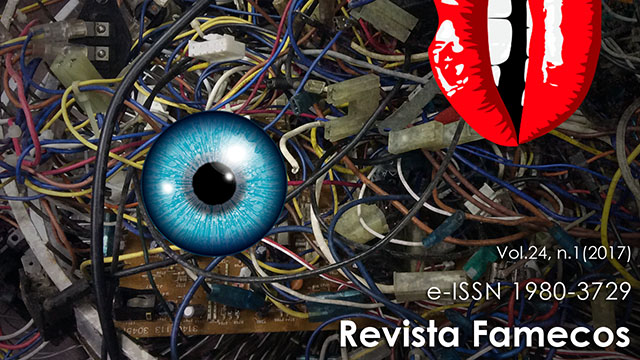The technomagic and the every-day – Sociology of public emotion
DOI:
https://doi.org/10.15448/1980-3729.2017.1.23719Keywords:
Communication, Technique, MagicAbstract
An immersion in the cell of contemporary culture reveals the advent of an imaginary inaugurating a unique synergy between the mind and the senses, between rational action and magical thinking. The worship of various fetishes that underpin our society holds for each person involved, a high degree of ecstasy and enchantment, but also a consciousness endowed with a memory and a highly refined know. Thus, the technique in his ancestral resonance and its seductive current forms again is the totem of society in pregnancy, your object of worship and its base of symbolic reference. His dream and its reality, as real as possible.Downloads
References
ATTIMONELLI, C. Techno: ritmi afrofuturisti. Roma: Meltemi, 2008.
BATAILLE, G. La part maudite. Précédé par la notion de dépense. Paris: Les Éditions de Minuit, 2003.
BENJAMIN, W. Le livre des Passages. Paris: Éditions du Cerf, 2006.
CASTELLS, M. La société en réseau. Paris: L’ère de l’information, Fayard, 1998.
CLARK, A. Natural born cyborg. Oxford University Press, Boston, 2004.
DAVIS, E. Techgnosis. Mith, magic and mysticism in the age of information. New York: Crown Publishers, 1999.
DEBORD, G. La Société du spectacle. Paris: Gallimard, 1992.
GIBSON, W. Neuromancien. Paris: Ed. “J’ai lu”, 1988.
GRAF, F. La magie dans l’antiquité gréco-romaine. Paris: Les Belles Lettres, 1994.
HAMPARTZOUMIAN, S. Effervescence techno ou la communauté trans(e)cendentale. Paris: L’Harmattan, 2004.
JENKINS, H. Convergence culture. Where old and new media collide. New York: New York University Press, 2006.
LÉVY, P. L’intelligence collective. Pour une anthropologie du cyberspace. Paris: La Découverte, 1994.
MAFFESOLI, M. Le Réenchantement du monde. Paris: La Table Ronde, 2007.
______ . Iconologies. Nos idolâtries postmodernes. Paris: Albin Michel, 2008.
MCLUHAN, M. The Gutenberg Galaxy. The making of typographic man. Toronto: University of Toronto Press, 1966.
______ . Pour comprendre les médias. Paris: Seuil, 2004.
______ . D’oeil à oreille. Paris: Hurtubise HMH, 1977.
MORIN, E. Le cinéma ou l’homme imaginaire. Paris: Les Éditions de Minuit, 1957.
SUSCA, V. La transmutation du monstre. Les Cahiers Européens de L’Imaginaire, La Barbarie, Paris: CNRS éditions, n. 1, jan. 2009.
______. Joie Tragique. Les formes élémentaires de la vie électronique. Paris: CNRS éditions, 2010.
TARDE, G. Les lois de l’imitation, Kimé, Paris, 1993.
WEBER, M. L’éthique protestante et l’esprit du capitalisme. Paris: Plon, 1964.
Published
How to Cite
Issue
Section
License
Copyright
The submission of originals to Revista Famecos implies the transfer by the authors of the right for publication. Authors retain copyright and grant the journal right of first publication. If the authors wish to include the same data into another publication, they must cite Revista Famecos as the site of original publication.
Creative Commons License
Except where otherwise specified, material published in this journal is licensed under a Creative Commons Attribution 4.0 International license, which allows unrestricted use, distribution and reproduction in any medium, provided the original publication is correctly cited.






